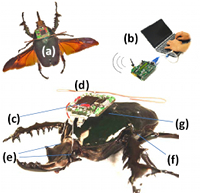Have you ever wanted your own army of implacable cyborg beetles?
Oh, come on, you know you have.
Wouldn’t it be great to take a beetle (a), attach a microcontroller (d) with electrodes (e) attached to the beetle’s nervous system and muscles, then control it via wifi (b).
 American researchers have apparently created a prototype beetleborg and had the poor godless bastard creature fly across a room under the radio control of its maniacal, scheming human masters.
American researchers have apparently created a prototype beetleborg and had the poor godless bastard creature fly across a room under the radio control of its maniacal, scheming human masters.
They built it out of a rhinocerous beetle, since they presumably happened to have one lying around. And because rhinocerous beetles are very strong for their size and have scary big horns. (Apparently they are also clean and make good pets too.)
Practical uses for the remote-control zombie insects include surveillance, finding people trapped under rubble and Egyptology.
I like to think that future models could be equipped with enhanced titanium horns which could be used to free hostages and cut telephone cables.
Anyway, this one scores a ‘9’ on my Meddling With Nature-ometer. Impressive, potentially useful, and fucking creepy.
I leave you with this fun fact about rhinocerous beetles from Wikipedia:
Rhinoceros beetles are also the strongest animals on the planet in relation to their own size. They can lift up to 850 times their own weight. To put this into perspective, if a human of average height and weight had the strength of the rhinoceros beetle, he would likely be able to lift a 65 ton object (e.g. an M1 Abrams tank).
